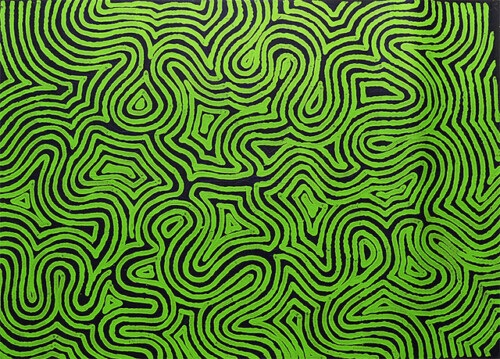The Queen’s Birthday this year added two top Aboriginal artists to the roll of honour. John Mawurndjul from Maningrida in Western Arnhemland and Peggy Patrick from the East Kimberley both became Members of the Order of Australia “ AMs.
Mawurndjul’s citation reads: For service to the preservation of Indigenous culture as the foremost exponent of the Rarrk visual art style – which is true enough in its second part “ the foremost exponent of rarrk “ but fails to acknowledge his huge advances purely as an artist, who developed his painting style from the more traditional representation of Dreamtime creatures from the Kuninjku theology during the 1980s to a virtual abstraction today that shimmers on his barks while still telling his fellow Kuninjku the stories of ceremonies that matter to them.
Mawurndjul has also maintained a remote lifestyle beyond the reaches of the Western world on his Milmilngkan family outstation where he paints, hunts and cares for his cave-painting dotted country.
From that fastness he has emerged to fascinate and challenge the rest of the world at exhibitions as significant as Les Magiciens de la Terre in Paris in 1989, Aratjara in Germany and England in 1993, Rarrk “ the first major one-man show overseas by an Aboriginal artist in Switzerland and Germany in 2005 – and of course, his permanent contribution as one of eight indigenous artists at the Musee du quai Branly in Paris the same year.
Johnny Mawurndjul has also taken on the world simply through his character “ making speeches at many of the above events in impenetrable Kuninjku, but leaving his audience convinced they’d understood every word! And, in the name of greater understanding, the Swiss National Science Foundation supported the publication of a multi-authored intercultural text in 2009 “ Between Indigenous Australia and Europe “ John Mawurndjul.
Peggy Dirrmingali Patrick is cited ‘For service to the arts as a performer, artist and storyteller, to the preservation of the culture and history of the Gija people of the East Kimberly region, and to reconciliation’. This feisty lady was not viewed as a reconciler by Keith Windschuttle. For, in recent years, she lead the Gija charge to tell the stories of whites massacring her people in as many ways as she could “ painting, story-telling and public joonba or performance.
Her triumph came through the Jirrawun Artists group and the Neminuwarlin Performance Group. Two major art exhibitions organised by Jirrawun “ Blood on the Spinifex in Melbourne and True Stories in Sydney “ were underlined by performances at the Perth and Melbourne Festivals in 2002 of Fire Fire Burning Bright, the joonba that Patrick lead the creation of.
But earlier in her life Peggy Patrick- sister to both the artists Timmy and Freddy Timms – had worked as a stockman, drover, station cook, brickmaker, windmill mechanic, barmaid, housekeeper, fencer, nurse, midwife, teacher, hunter and keeper of the traditional Gija women’s law. Her mother’s mother and father and their brothers and sisters were all killed at the Mistake Creek Massacre on the edge of Bow River Station “ encouraging Patrick to make an emblematic panel of paintings slightly reminiscent of Warhol setting the stencilled black boab tree that stands beside Mistake Creek against a variety of different ochre-toned backgrounds.
Fire Fire Burning Bright, on the other hand, commemorated the Bedford Downs Massacre where a number of Aborigines involved in the killing of a cow were poisoned and their bodies burnt on a fire they themselves had built. The joonba telling this sad tale had been hidden by the Gija until 2000 for fear of retribution. Indeed, performers at the Perth Festival debut feared shots from an audience that in fact greeted them with tears.
After this catharsis, Patrick and the now-defunct Jirrawun have seemed less confident of their direction. But an enormous amount has been achieved to clear the air in the East Kimberley.





